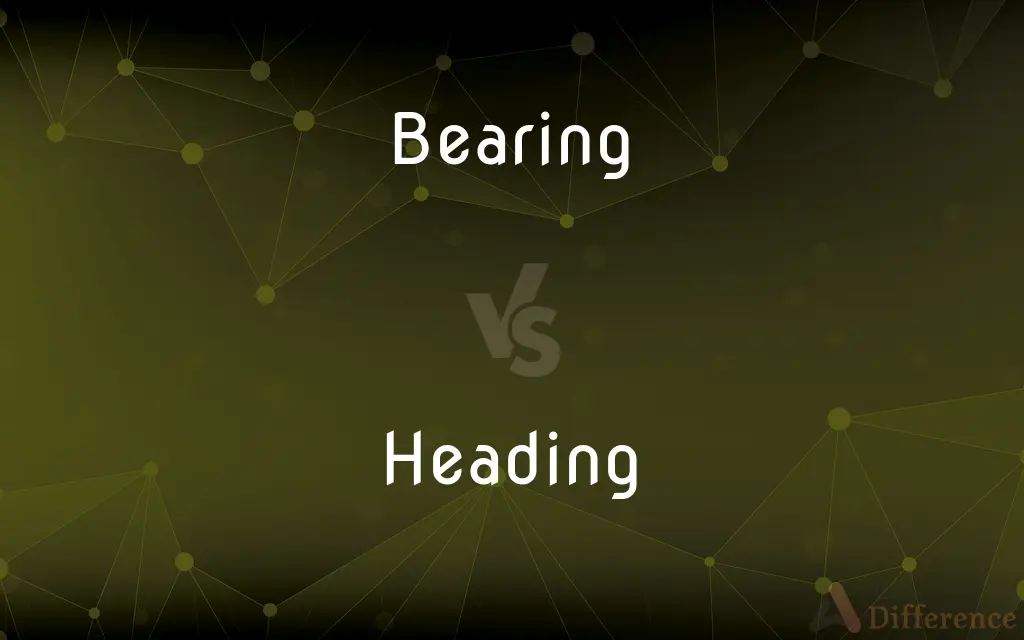Bearing vs. Heading — What's the Difference?
By Fiza Rafique & Urooj Arif — Updated on March 17, 2024
Bearing is the direction or angle between two points, often used in navigation, while heading refers to the direction in which an object or vehicle is currently moving.

Difference Between Bearing and Heading
Table of Contents
ADVERTISEMENT
Key Differences
Bearing is a navigational term that denotes the angle between a reference direction, typically true north, and the line from the observer to a specific point or destination. It is usually expressed in degrees, indicating the direction one must follow from their current position to reach a particular point. Heading, on the other hand, refers to the direction in which the front of a vehicle, aircraft, or vessel is pointed at any given moment, relative to a reference direction like true or magnetic north. It is also expressed in degrees and is crucial for navigating and maintaining the intended course.
While bearing is concerned with the angle or direction to a target point from one's current location, heading focuses on the immediate direction of travel. For instance, a ship may have a heading that constantly adjusts due to sea conditions or to navigate around obstacles, while its bearing to the destination remains constant until the destination itself is reached or the starting point changes.
In navigation, both bearing and heading are essential for accurate positioning and direction. Bearings help determine the course to a destination, while headings are used to maintain the direction of travel. The difference between one's heading and the bearing to a destination can indicate whether they are on course or need to adjust their heading.
The concepts of bearing and heading are particularly important in aviation and maritime navigation, where precise direction and positioning are critical. Pilots and captains must constantly monitor both their heading and the bearing to their destination to ensure they are on the correct path, adjusting their heading as necessary to account for factors like wind or currents.
Comparison Chart
Definition
Angle from one point to another, relative to a reference direction
The direction in which the front of a vehicle or vessel is pointed
ADVERTISEMENT
Reference Point
Often a fixed destination or object
The vehicle or vessel's current direction
Measurement
Degrees from a reference direction (e.g., true north)
Degrees from a reference direction (e.g., true north)
Use
Determining the direction to a destination
Indicating the current direction of travel
Dynamic/Static
Static relative to the observer and the target
Dynamic, can change as the vehicle or vessel moves
Compare with Definitions
Bearing
Bearing is used in navigation to determine the direction to a destination.
The navigator calculated the bearing to ensure we were headed towards the island.
Heading
Heading refers to the direction the front of a vehicle or vessel is facing.
The captain confirmed the ship's heading was due east.
Bearing
Relates to a reference direction like true north.
The pilot adjusted the course based on the bearing from true north.
Heading
Used to maintain a vehicle on its intended path.
He checked the compass to ensure their heading remained steady.
Bearing
It's the angle measured in degrees between two points.
The bearing from the ship to the lighthouse was 045 degrees.
Heading
In aviation, it's the direction the aircraft is pointed.
The pilot adjusted the plane's heading to avoid the storm.
Bearing
A fundamental concept in navigation practices.
Understanding bearing is crucial for successful orienteering.
Heading
Critical for accurate navigation and steering.
Constantly monitoring the heading is essential for a smooth sail.
Bearing
Helps in orienting oneself in the environment.
Using a compass, he determined the bearing to the campsite.
Heading
Can change as the vehicle or vessel moves.
The car's heading changed as it turned onto the highway.
Bearing
The manner in which one carries or conducts oneself
The poise and bearing of a champion.
Heading
A title at the head of a page or section of a book
Chapter headings
Bearing
A machine or structural part that supports another part.
Heading
A direction or bearing
He crawled on a heading of 90 degrees until he came to the track
Bearing
A device that supports, guides, and reduces the friction of motion between fixed and moving machine parts.
Heading
A horizontal passage made in preparation for building a tunnel.
Bearing
Something that supports weight.
Heading
A strip of cloth at the top of a curtain above the hooks or wire by which it is suspended.
Bearing
The part of an arch or beam that rests on a support.
Heading
The title, subtitle, or topic that stands at the top or beginning, as of a paragraph, letter, or chapter.
Bearing
The act, power, or period of producing fruit or offspring.
Heading
The course or direction in which a ship or aircraft is pointing or moving.
Bearing
The quantity produced; yield.
Heading
A gallery or drift in a mine.
Bearing
Direction, especially angular direction measured from one position to another using geographical or celestial reference lines.
Heading
The end of a gallery or drift.
Bearing
Often bearings Awareness of one's position or situation relative to one's surroundings
Lost my bearings after taking the wrong exit.
Heading
Present participle of head
Bearing
Relevant relationship or interconnection
Those issues have no bearing on our situation.
Heading
The title or topic of a document, article, chapter, or of a section thereof.
Put the information under the "Advantages" heading
Bearing
(Heraldry) A charge or device on a field.
Heading
(nautical) The direction into which a seagoing or airborne vessel's bow is pointing (apparent heading) and/or the direction into which it is actually moving relative to the ground (true heading)
Bearing
(Architecture) Designed to support structural weight
A bearing wall.
Heading
Material for the heads of casks, barrels, etc.
Bearing
Present participle of bear
Heading
(mining) A gallery, drift, or adit in a mine; also, the end of a drift or gallery; the vein above a drift.
Bearing
(in combination) That bears (some specified thing).
A gift-bearing visitor
Heading
(sewing) The extension of a line ruffling above the line of stitch.
Bearing
Of a beam, column, or other device, carrying weight or load.
That's a bearing wall.
Heading
(masonry) The end of a stone or brick which is presented outward.
Bearing
(mechanical engineering) A mechanical device that supports another part and/or reduces friction.
Heading
(flags) A strip of material at the hoist end of a flag, used for attaching the flag to its halyard.
Bearing
The horizontal angle between the direction of an object and another object, or between it and that of true north; a heading or direction.
Heading
The act or state of one who, or that which, heads; formation of a head.
Bearing
One's understanding of one's orientation or relative position, literally or figuratively.
Do we go left here or straight on? Hold on, let me just get my bearings.
I started a new job last week, and I still haven't quite found my bearings.
Heading
That which stands at the head; title; as, the heading of a paper.
Bearing
Relevance; a relationship or connection.
That has no bearing on this issue.
Heading
Material for the heads of casks, barrels, etc.
Bearing
One's posture, demeanor, or manner.
She walks with a confident, self-assured bearing.
Heading
A gallery, drift, or adit in a mine; the vein above a drift.
Bearing
(architecture) That part of any member of a building which rests upon its supports.
A lintel or beam may have four inches of bearing upon the wall.
Heading
The extension of a line ruffling above the line of stitch.
Bearing
(architecture) The portion of a support on which anything rests.
Heading
That end of a stone or brick which is presented outward.
Bearing
The unsupported span.
The beam has twenty feet of bearing between its supports.
Heading
A line of text serving to indicate what the passage below it is about;
The heading seemed to have little to do with the text
Bearing
(heraldry) Any single emblem or charge in an escutcheon or coat of arms.
Heading
The direction or path along which something moves or along which it lies
Bearing
The manner in which one bears or conducts one's self; mien; behavior; carriage.
I know him by his bearing.
Heading
A horizontal (or nearly horizontal) passageway in a mine;
They dug a drift parallel with the vein
Bearing
Patient endurance; suffering without complaint.
Bearing
The situation of one object, with respect to another, such situation being supposed to have a connection with the object, or influence upon it, or to be influenced by it; hence, relation; connection.
But of this frame, the bearings and the ties,The strong connections, nice dependencies.
Bearing
Purport; meaning; intended significance; aspect.
Bearing
The act, power, or time of producing or giving birth; as, a tree in full bearing; a tree past bearing.
[His mother] in travail of his bearing.
Bearing
That part of any member of a building which rests upon its supports; as, a lintel or beam may have four inches of bearing upon the wall.
Bearing
The part of an axle or shaft in contact with its support, collar, or boxing; the journal.
Bearing
Any single emblem or charge in an escutcheon or coat of arms - commonly in the pl.
A carriage covered with armorial bearings.
Bearing
The situation of a distant object, with regard to a ship's position, as on the bow, on the lee quarter, etc.; the direction or point of the compass in which an object is seen; as, the bearing of the cape was W. N. W.
Bearing
Relevant relation or interconnection;
Those issues have no bearing on our situation
Bearing
The direction or path along which something moves or along which it lies
Bearing
Dignified manner or conduct
Bearing
Characteristic way of bearing one's body;
Stood with good posture
Bearing
Heraldry consisting of a design or image depicted on a shield
Bearing
A rotating support placed between moving parts to allow them to move easily
Bearing
(of a structural member) withstanding a weight or strain
Bearing
Producing or yielding;
An interest-bearing note
Fruit-bearing trees
Common Curiosities
Why is it important to know both bearing and heading in navigation?
Knowing both allows navigators to determine the direction to a destination (bearing) and adjust their current direction (heading) accordingly.
How is bearing measured?
Bearing is measured in degrees from a reference point, usually true north or magnetic north.
What is the difference between bearing and heading?
Bearing is the directional angle from one point to another, while heading is the direction in which a vehicle or vessel is currently pointed.
How does wind or current affect bearing and heading?
Wind or current can cause a vehicle to drift off course, requiring an adjustment in heading to maintain the correct bearing.
Can bearing and heading be the same?
Yes, bearing and heading can be the same if a vehicle is directly on course towards its destination.
Are bearings always fixed?
Bearings to a destination remain fixed, but the bearing between two moving objects can change.
Why might a pilot's heading differ from the bearing to a destination?
A pilot might adjust the heading to account for wind conditions, ensuring the aircraft remains on the correct bearing.
What is magnetic declination, and how does it affect bearing and heading?
Magnetic declination is the difference between true north and magnetic north, affecting both bearing and heading calculations.
Is heading more important than bearing?
Neither is more important; both are essential for accurate navigation.
How do sailors use bearing and heading?
Sailors use bearing to determine the direction to their destination and adjust their heading to navigate effectively.
Can heading change without changing the bearing?
Yes, a vehicle's heading can change due to maneuvering or environmental factors without altering the intended bearing.
What is a reciprocal bearing?
A reciprocal bearing is the opposite direction of a given bearing, useful for returning along the same path.
How do navigators adjust for differences between bearing and heading?
Navigators adjust the heading to compensate for drift, currents, or wind to maintain the correct bearing.
Can GPS devices show bearing and heading?
Yes, most GPS devices can display both bearing to a waypoint and the current heading.
How do pilots ensure their heading matches the bearing?
Pilots use navigation instruments and adjustments to align their heading with the desired bearing, considering wind and other factors.
Share Your Discovery

Previous Comparison
Celebrated vs. Famous
Next Comparison
Contentious vs. ControversyAuthor Spotlight
Written by
Fiza RafiqueFiza Rafique is a skilled content writer at AskDifference.com, where she meticulously refines and enhances written pieces. Drawing from her vast editorial expertise, Fiza ensures clarity, accuracy, and precision in every article. Passionate about language, she continually seeks to elevate the quality of content for readers worldwide.
Co-written by
Urooj ArifUrooj is a skilled content writer at Ask Difference, known for her exceptional ability to simplify complex topics into engaging and informative content. With a passion for research and a flair for clear, concise writing, she consistently delivers articles that resonate with our diverse audience.














































